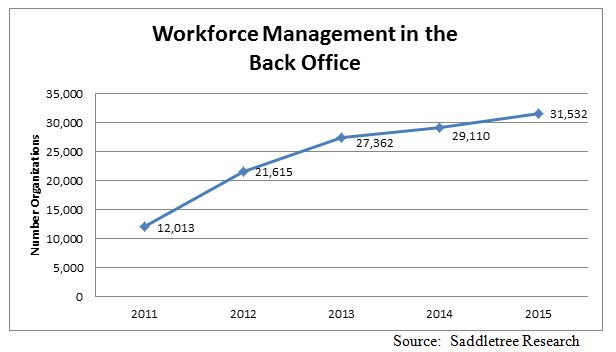Back-Office Workforce Management: The Second Wave
It was in 2011 that the back office first came to our attention at Saddletree Research as a potentially disruptive force in the global contact center industry.
Although the back office was an entirely separate operation from the front office contact center in most enterprises, the similarities between the two entities indicated a need for further investigation. As a result, we initiated our first back office research project five years ago.
Our inaugural research project involved surveying and interviewing 120 customer service professionals who were members of the National Association of Call Centers (NACC), a 501(c)(6) not-for-profit membership organization at The University of Southern Mississippi. At the conclusion of this project we made the surprising discovery that nearly 60 percent of enterprises in the U.S. had the front office contact center and the back office contact center reporting to the same internal organization.
The majority of U.S. enterprises had apparently already recognized the management economies that were the result of a unified approach to front office/back office administration. This initial management merger represents what we refer to as the first wave of unification between the front office and the back office in the customer service profession.
From 2011 through 2014 the percentage of enterprises that had the contact center and the back office reporting up to the same organization remained relatively steady, increasing from 60 percent in 2011 to about 66 percent in 2014. Further research revealed that the number of back office operations that were adopting contact center-style workforce management as a means of scheduling and managing the workers in the back office saw significant growth in the early years before leveling off in 2013 – 2014. The graph below illustrates the growth of workforce management (WFM) software in the back office during the period 2011 through 2015.

The year 2015 represents the beginning of the second wave of activity that will further bring together the front office and back office in terms of resource sharing. Resource sharing across the enterprise during the first wave was more informal and organic in nature and, frankly, represented the low hanging fruit. The second wave will be different.
In 2015 we found that 73 percent of U.S. enterprises have the contact center and the back office reporting to the same internal organization, but only 45 percent of U.S. enterprises are utilizing workforce management software in the back office. This discrepancy can be blamed primarily on the complexity of many back office workflows and the challenges they present to contact center workforce management.
The second wave of shared resources in the enterprise will be driven not only by economies of scale but by refinements in workforce management software that recognize and specifically address the complex challenges presented by back office activities. Second wave WFM software offers capabilities such as scheduling for multi-step work processes and work teams rather than individual workers. The ability to track work to be completed and to track backlogs of work has also been enhanced. These back office-specific capabilities will accelerate the adoption of back office WFM during the second wave, which we expect to remain strong through the year 2020.
As contact center disciplines and solutions continue to be applied to the back office in the years ahead, further refinements in workforce management software will serve to propel the deployment of shared resources in the enterprise. The second wave of back office workforce management promises to be an exhilarating ride for the contact center industry.
Saddletree Research will explore this topic further during an April 21, 2016 webcast titled “Ask the Experts: Enterprise Workforce Management.” This Q&A forum session co-hosted by Verint will explore market trends, best practices and tips, and ways to break down silos across contact center and back-office operations. Click here to register and learn more.
The post Back-Office Workforce Management: The Second Wave appeared first on Customer Experience Management Blog.
Leave a Comment
You must be logged in to post a comment.







